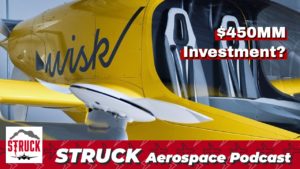GM just unveiled a new EVTOL concept – will it actually work? Bombardier has a high-tech wing factory – what makes it so unique? We also discuss Jaunt Air Mobility’s pursuit of a potential hybrid power source and news of Archer partnering with Fiat Chrysler on the EVTOL front.
Learn more about Weather Guard StrikeTape segmented lightning diverter strips. Follow the show on YouTube, Twitter, Linkedin and visit us on the web. Have a question we can answer on the show? Email us!
Podcast: Play in new window | Download
EP43 Transcript – Bombardier’s Wing Factory; Jaunt Explores Hybrid Fuel System & GM’s new EVTOL Concept?
All right. We’ll come back to the struck aerospace engineering podcast. I’m your co-host Dan Blewett on today’s podcast. First thing we’re gonna talk about in the new section, unfortunately is the, the crash of the recent 737 500 aircraft out in Indonesia. So we’ll talk a little bit about that. In our second segment, we’re going to talk about Bombardier.
They have a pretty amazing factory where they produce wings and they’re pretty just high-tech in general, Allen’s worked there in the past. So we’re gonna talk about some of their tech as far as their assembly line goes and all that stuff. And in our EVTOL segment today, we’re going to talk about JASA merging it’s general aviation and VTL certification.
John exploring their fuel system to potentially extend the range, which is something we actually chatted about last week, Archer finding a production partner and GM their their crack at the EVTOL market. And how far it’s now lagging behind. So, Allen, let’s start with the Boeing seven 37 so that crashed out of Indonesia.
It has gotten a lot of press, obviously, cause you know, terrible, terrible accident. But it wasn’t in the air very long. And then it seems a plummeted 10,000 feet in less than a minute. And can you just shed some perspective on that? That seems like a really precipitous drop. Yeah. Th
th the aircraft was at about 10,000 feet.
It had taken off and headed over the, over the water and then just seem to disappear. And there were some reports from some ships nearby that watched the aircraft plummeted to the ocean, and then it satellite that the aircraft was essentially. Full nose, dive right into the water, which indicates really one of two things that the aircraft has, something, something severely wrong with it, then yeah, you can kind of get in those situations, you stall it and push the nose down and continue to push the nose down.
And then obviously you will crash that sort of situation. But most aircraft, when they have some power plant problem of some sort, don’t go plummeting downward like that. The airplanes are. Can glide. And you would think you would try to set it up to glide, but it just leads you to think that one of two things happen here, either the pilot slash pilots decided that for whatever reason they were disoriented or they were, and maybe in some cases there’s been cases of suicide suicides that they just put the nose down and drove it into the water.
The other possibility is you have some control flight surface. Anomaly where it just drives a nose down in the pilots. You can’t fight it off. As soon as they find the black boxes for that aircraft are going to have a pretty good indication. And then in an hour or two, usually of what the flight parameters were, airspeeds attitudes cockpit.
Cockpit voice recorder will tell you a lot. I could have some previous crashes, so there’s a lot still to be learned here, but this is not, I think the, one of the first things that happen and every ticket held their breath. As soon as I saw this news was. Is it a, is it a max airplane, right? Is it something to do with the M cast system?
You know, weird things happen? It doesn’t sound like it’s a dash 500. Right. And it was built back in the nineties. Is that
26 years old? That plane? Yeah. Okay.
So it’s been around a long time. I’d also heard it was a former continental aircraft. It came from the United States originally flew livery here, and then it was purchased in Indonesia.
So the airplane has a lot of flight history around the United States. Obviously all the mechanical logs go along with the aircraft. So if there was sort of weird structural flight control issue with the aircraft, going back to the maintenance logs would tell you a lot about it. So I think we just got to let the investigators take a look at it.
Do their deep dive, try to find the black box. That’s the, one of the worst parts about crashing into the ocean is trying to find the black boxes and black boxes have a little beeper on them. There’s activated when they. And then there’s sea water, water around. And so it’ll start making pinging noises that, and I don’t remember how long that lasts but it helps helps the crews locate where the aircraft is and try to find the black box because there’s that really the one piece of information you really need off the airplane is that black box.
And then if they can recover, which they
actually have found them. Good.
How deep was that aircraft? Did they say how our cuff was under water? Was it a thousand feet or a hundred feet under the water? Because that’ll make a big difference on what the analysis is that they can pull something.
Oh, they’re only rated.
So like a certain pressure level, the black box, like the
black box, the black box is fine. It’s but the, the, the wreckage crew, th th th the, the ability to remove that from the sea bottom. This is limited by how deep it is. That’s why a lot of aircraft are not recovered and they have the little submarines go down and look at them.
But if they can actually pull some of the aircraft back up, then you have a much better sense of recreating the aircraft before it
crashed. Yeah. Yeah. I can’t find that that data from any of the articles I’ve read, but yeah, oddly enough, a fishermen saw it go into the water, which is crazy. Can you imagine seeing something like that, man?
So just hit, hit the water, like lightning and just exploded.
Well, the, the, having an eyewitness is actually very helpful because you can eliminate a number of things. Was it aircraft on fire? Yes or no? W was the aircraft intact? Like, was it missing a tail or is it missing an engine? Most people will have a hard time discerning that kind of stuff, but if they, if it is something they had seen that it’s helpful in the in accident investigation, those eye witnesses, having looked at a lot of.
Accident, eye witness accounts. They will vary a lot. If you have a large group of people has seen that accident occur. They’ll have a lot of varying opinions of what actually happened in front of, but usually if the aircraft’s on fire, they can tell it if the aircraft is missing, an engine is. One thing they can usually tell.
So it at least put some parameters about what the possibilities of the crash were
in our engineering segment today, we’re going to talk about bombard EA and they have a pretty amazing production facility overseas, Alan, you’ve been there before. Right. And you attest to the fact that this place is. Is just a, a modern Marvel essentially. You know, they, they create wings, they create lots of different parts, but one of their things is they’ve they assemble their wings with a lot of pre fragmented carbon fiber.
And that’s just a really. Complicated process in the way that they’re made. Right. And obviously everything in the aircraft industry is as incredibly precise. But you said their facility here just seems to just take everything to the, to the next level. Yeah. So
Bob already sold the facility at the end of 2020.
I think that finally, that transaction finally happened. So spirit aerospace now owns a facility. But it’s the same group of people. It’s the same facility that I participated in tennis years ago when we were working on the, on the C series, 80 20, and on the leader there jet 85 the technology. The the carbon fiber composite technology in Northern Ireland is amazing.
No, no thing can to really describe the capabilities they had in that facility. So he had built a, a brand new facility. At the cause they’re right on the water. So if you’re ever visit Belfast and go to the now spirit facility, it is right on the water where the ship docks used to be, where they used to make ships like the Titanic was made just down the road from where the wing of some wing manufacturing facility is for now spirit.
But they had built a brand new facility. And it’s a huge facility and not had opportunity to be in there a couple of times where they’re manufacturing the C series, a two 20 wing, and it is amazing. It’s like walking inside of a spaceship. There is so much technology and engineering going on in that facility to make these composite wings.
And they had to develop a means of what they call a resident transfer infusion. So they’re essentially Putting carbon fiber in place. That’s sort of tacked together. So stringers and spars kind of get all put together and then they’re making and they’re let me, let me describe this way. So when they’re, when they’re, when they’re making a wing scan, they’re basically laying down what is essentially dry fabric and, and putting in some stringers and things into it, and then injecting a poxy into that mold and then curing it.
That leads itself to a lot of efficiencies. So there’s, you’re not working with a necessarily a prepregs material, which is tacky and there’s exposure issues. How much time it can be out. And how’s it all clear up and they’re making fairly thick assemblies and they were the trick that the RTI process was able to do was really compact all the carbon fiber and get the right amount of resonant to it consistently.
And that’s hard to do on very, very thick composite structures. And the 80 to 20 wing is very thick relatively speaking. So they were able to do things that I had not seen before. And the consistency of that of it was amazing. The other part about what Belfast technology was at the time is that they were designing the aircraft under the new lightning.
And fuels system safety rules, which put a lot of features into the wing to prevent arching and sparking from either electrical failures or from lightning and other. Bad situations, but essentially they had designed the wing to be, it’s gotta be the safest wing at the time ever developed in terms of its protection against arketing its parking into the wing.
And they did that through a lot of technology advancements and they, they advanced materials, advanced design techniques. They advanced failure analyses and a whole. Plethora of different things you wouldn’t think would come out of a facility like that you think like Boeing would do that, or Airbus would have the, have the capability of doing that, but it really just came out of Belfast and it was just, it was amazing to watch.
I was there, I don’t know, probably seven, eight, nine, maybe 10 times overall. And every time you go there, you’re just like, your eyes would open it up again. Like, wow, there’s something amazing going on at this facility. Because a lot of times when you go visit an aircraft facility you know, the, a lot of the things are old.
It’s just old, old technology. It’s an old facility it’s kind of dirty. It’s industrial. It handles, it has all those little features like going into an old automotive. Factory similar feel, but in Belfast, it wasn’t like that at all. This, this new facility was just completely different and an amazing, so I know that there’s just keeping tracks track on what they’ve been doing lately.
They they’re making some other advancements. Queens university has a site at the. Spirit facility on campus. Right, right there, right near the front gate. So they’re working with the local university and all kinds of other universities and technology centers around them to improve their products.
And I always think their products are amazing. So I just like watching the technology jump out of there because it’s such a cool facility and it’s full of really, really bright
individuals. So, I mean how have you seen. Like production facilities evolve over the years. I mean, obviously they’re still continuing to, I assume they have a really long shelf life number one.
So that probably, I don’t know, does that stifle, it stifle innovate innovation. Does it always take a brand new, physical building to really make big leaps and advances in like production technology? It does. I
do think there’s a mental aspect to that and you can feel it in the way the employees react.
When you walk into a facility that’s. Know, sort of pre world war II or just post-World war II facility, which is what a lot of air aircraft companies still operate in. You can tell it’s a whole things don’t work, right? It’s dirty and dusty because it’s industrial and it just all general wear and tear happens.
And I always feel like there’s not gonna be a lot of innovation there because everything says to you. Old aged not new, right? Nothing new is being invented here. And in fact, in a lot of cases, they’re still building the same airplane. They were building back in the 1950s or sixties in the same spot.
So nothing has changed in 50, 60 years. So you get that and you get that feeling right. And that also, I think it just builds upon nothing. New is going to be invented here. And when you do build a new facility, Even with all the expense of it. Right. But I think it just opens up mental doors to people, the, the, the sights and the sounds and the smells everything’s fresh.
And that. I do think that opens up creativity. I think a lot, a lot of times out in Silicon Valley, they’re all on these new facilities and are changing the way that what they’re seeing, there’s more windows or all those different things you don’t necessarily see in, in an industrial environment, you see a more aggressive, a quicker pace technology companies get rid of all that stuff and get away from all that old, old world kind of an industrial environment, just because I do think it produces more innovation.
I think it does
in our last segment today, we’re going to talk about EBTL Wells and a so first on the docket JASA is sort of refiguring its Certification merging the departments that will handle their fixed-wing and their vertical takeoff and landing aircraft which will also include drones. So, Allan, obviously you speak all the time about certification, just how difficult it is.
Does this seem like an obvious move to you? Does it seem to make sense? Well, there’s a, there’s a lot
going on. And I’ve been reading really conflicting stories lately about the certification world. So IIASA is creating new rules where for EBIT two, L’s where the FAA is not. The FAA is saying, I have the existing roles, and that is a dichotomy that we don’t see very often where the European regulators and the United States, regulators are not on the same wavelength here, because you want to have consistency across those certification groups.
For example if I’m making a, a small part 23 light light aircraft, I want to be able to sell that in the United States and Europe. And not have any additional rules back. Eons ago now Europeans had different rules than the Americans. So you certify the airplane in America, then have to go do a bunch of extra stuff to certify it in Europe.
And it just led to barriers of entry. That’s what it does. It slows down your ability to recover your investment in this product, because even though your marketplace is in the United States and it’s 300 million. Person marketplace. You still like to pick up Europe because there’s a lot of business aircraft activity or smaller aircraft activity over there.
So the EVT all differences, certification approaches is I think really unique and I have not heard of a merger yet. Usually they try to get everybody together and work out differences. Haven’t heard it yet. So if I’m a EBTL maker in Germany, like Lilium, I am concerned that I’m going to have to have two separate rules because Lilium may be successful in Europe, but they really need to get that offered into America also.
And having two sets of rules is going to be okay. Just added, added cost with probably not much difference in safety.
Yeah. Gotcha. So moving on John air mobility is considering partnering with a vertigo arrow. And if you don’t know about vertigo, they produce a jet, a hybrid electric systems with a hundred kilowatt or 180 kilowatt generator, coupled to a high efficiency battery packs.
So Alan, we talked about this last week where, you know, the. Legitimacy of some of these CVT oil companies is going to depend on the range and the battery technology. Can they actually make these flights and, you know, make numerous flights in a day. They can’t just fly to Manhattan from long Island once and then recharge for six hours.
So John, which, you know, they have the, the site, the gyrocopter sort of design. They’re one of the they’re not afraid to, it seems like explore this hybrid electric and battery powered model, which probably makes sense. And at least a certain percentage of the EBTL market probably needs to do that.
Right. Because otherwise everyone’s going to be maxed out. If everyone only uses battery power, everyone might be maxed out the very short trips. How do you feel about this potential partnership? I think
it’s the first of many. And I bet you there’s more activity going on on that front then, than we even can imagine.
Right now, the battery technology is going to be limited. And if you are. Intending to make multiple trips, short trips in a day, then either you’re going to be pulling batteries in and out. Like the sort of the pipistrelle design will allow you to do. You can actually pull it out and plug another series of batteries in, or you’re going to have to have an auxiliary power source to supplement the, the battery.
Charge system, battery energy storage system. That’s there. Otherwise you’re gonna be sitting on the ground a long time. There’s no, nothing wrong. I think there’s some. Feeling that if it’s not 100%, plug it in, charge it, fly it, that it’s doesn’t have any value in the marketplace. That’s a very invalid approach.
I think if you have a design that is much more versatile and it can fly along longer ranges and do multiple flights in a day is much more valuable than the one that it can then an aircraft that can only make two flights. So I would envision. Multiple other sorts of technology, like we’ve seen some hydrant, hydrogen technology pop up recently, there’s going to have to be some play for that, this Jedi systems.
There’s going to be some play for that because at the end of the day where you want to get to is. You do want to be able to plug it in quickly recharge it, that being an ideal, but we’re just not there yet in terms of battery technology and recharging technology and all the other fronts we may get there in the next couple of years, but I got to sell airplanes today to keep my airplane company alive.
So make the sacrifice put in the additional power system. So he can go at least start production and selling aircraft. I think that’s the minimum you got to do right now. So I think we just got to keep listening to see where more of these things are gonna happen. And I also kind of wonder with some of the automotive companies coming into play and joining forces with the V two L players.
If that’s part of it is coming in with essentially the ability to make high efficiency turbine. Gas burning systems that create electricity, that would, that would. Also make a lot of sense, so we’ll see how it plays
out. So next up here is a Archer. So we’ve talked about our art deviation briefly on the show in the past.
They have a prototype looks very interesting and they’ve partnered with Fiat Chrysler automobiles, FCA, and they’re hoping that FCA can give them some input into cockpit design. And a lot of those things that the automaker, you know, has been using in their cars And of course Archer’s design is potentially going to give them up to 60 miles at a top speed of up to one 50 miles, miles per hour.
But do you feel like small, this is my question for you, Alan, do you feel like small companies like this need to partner with these bigger firms, these automobile companies like is that partnership makes sense? I think
at a top level it does one, there may be some financing going on. So some funding may be coming from Fiat Chrysler.
That will help propel the aircraft to being, becoming a reality. Great. I think there’s also this assumption that the procurement system within a automotive manufacturer is probably pretty robust and they know how to drive down costs and, and to purchase things in quantity to drive down that cost while also maintaining quality.
And if you’re a new aircraft company, you don’t have that, those people on staff. Well, Fiat Chrysler does. And they clearly do. And then the assembly aspects and how to make a factory work, which is sort of the Toyota Joby situation that if you’re going to make as many aircraft of which you’re promising to make, and, and then you need to really set up your factory in a certain way to be efficient, if have cross Chrysler can do that.
Also, I always think when. A heavy industrial company comes into an aircraft company. Aircraft companies tend to produce things in dozens. We may produce a dozen aircraft a month, something like that. And then you got a company that is, is making dozens of. Cars a minute that there’s, sir, there’s so different on perspective that all the information you’re getting from the automotive company is coming like a fire hose at you.
You can’t absorb all the things are talking about that quickly and try to react to it. And the automotive company is going, why can’t you aircraft guys figure this stuff out? So they’re just, they’re just living on different planets. And th th th and it’s going to be very hard for them to even talk the same language about how to do this thing, because the aircraft.
Engineers are all about safety and reliability and all these other things and Fiat Chrysler, any automotive manufacturers about shoving cars out the door consistently repeatably, both listings can co-exist, but there really hasn’t been an aircraft company that has done that in a long time. So when you bring in a partner of that size, I think there’s a lot of.
Risk for both sides that it just, this whole thing is just never going to work. Because you almost need somebody in, in, in the middle to negotiate both sides. That explained what East side is talking about, because it does feel like that you feel like this automotive persons. Talking about putting on wheel lugs and we’re talking about putting a wings.
What, how can they help them? Yeah.
Right. I mean, I could see, especially from like higher up executives who have, you know, automotive production experience, whereas maybe some of these, like this new company that doesn’t have an aircraft yet. But getting from one aircraft to thousands of aircraft that requires a lot of scale and production lines and, you know, nimble like choices of design and also parts, you know, Elon Musk has talked about this.
He’s like, we don’t want to just design the best new battery. We need to design the battery that can make sense for thousands and thousands and millions of cars. So. You’d think they could help with that. But I think you’re right. That in the day to day, like gritty of it, it might be hard to marry the two types of engineers and figure out how they’re gonna to work together when they’re their designs are fundamentally very different.
Yeah. I definitely think so. My original. When I came out of college, we used to work for what was general electric became Lockheed Martin. And we made spacecraft. So you talk about the lowest production rate of anything in the world, but the, probably the most complex thing in the world. So we made a one or two or three of these spacecraft and the amount of rigor going into every single one of them was just.
Absolutely off the charts and moving into the aircraft industry. It’s like there was no controls at all. That’s what it appeared like to us. There was like no controls on anything that you couldn’t track parts. You don’t know where that part necessarily came from the level of detail. There, wasn’t sort of the planning and the controls that we had seen in spacecraft.
This is a totally different world than if you take that down to the next level or over to the next level. So automotive is going to be even less. So any particular vehicle running down a Detroit. Manufacturing line does it, it’s not really an individual, like it isn’t an aircraft. It’s just being sort of pushed out down the down the factory line with, you know, there’s a lot of details that go into it, but it’s just not the same level of rigor.
And until you can become comfortable with that, you always think that it’s chaos and it’s not chaos. It’s organized chaos, I guess. But. It’s it’s, there is a method to the madness and it’s just very difficult for an aircraft company on automotive company to try to join together. I think that has not proved fruitful in the past.
Yeah. Well, and speaking as our last topic for today is you know, general motors unveiled a, a Cadillac. Branded personal drone a number of years ago and kind of reporting back, circling back to them. It’s, you know, Jim was hoping that it would get to speeds of up to 56 miles per hour and be a rooftop to rooftop.
Sort of personal travel device. The design is very bizarre and unlike anything that exists currently, real aviation and you know, this article out of ebtl.com just says, you know, like they’re very far behind other designs nowadays with, you know, more and more players coming into the market. So I know how you’re going to.
Feel about this. So why don’t you just come out, come out with it?
I don’t understand why they’re even trying, honestly, it’s not in their level of expertise. It makes no sense. It’s not going to drive customers to buy the cars. Where, what technology are they going to possibly develop? And an aircraft that they’re gonna apply it to cars or cars into an aircraft.
I just don’t see it. And they have no expertise in certifying anything aircraft related and that which they would have to do. So what is the point of this? I don’t, I don’t understand what the point of that is because I wouldn’t buy an aircraft from general motors. So last time, general motors or Ford or any other.
Chrysler, any of the other automotive manufacturers in America built aircraft was world war II. And after world war II wrapped up, they immediately got back into the car business. They were not going to make airplanes. And so that there’s sort of tinkering around with that. Any automotive company tinkering around with it at that level.
Doesn’t make any sense. Honda years ago, I thought did it the right way and which they basically created a separate division and it was a pet project for awhile and not about that, but they actually set up a separate division to learn all the stuff they need to go learn. And then when they had a really very productive and useful design to then decided to build a factory and make it, and that has been.
Productive, but that was like a dad was like a 20 year development program. I don’t see GM spending three years developing this because the return on an investment and United States. So it was different than Honda was doing at the time over in Japan. GM can’t do that. Not now. So why.
Why toy with it? Well, well, I misspoke.
This is a brand new design. This is not a couple years old design is a brand new design. But they just appear multiple years behind based on the design they’ve released. And it seems like GM is excited about their their battery technology. And they’re just trying to find more places to put it.
That seems like the whole impetus, which is that like I said they said, well there battery systems called Al Al Altium, U L T I U M. I don’t know much about it beyond that, but, you know, I think now they’re just trying to seem like they’re just trying to fit more uses to it, which seems misguided.
Well, if you’re trying to compete on the marketing side with Tesla, Tesla’s not even trying to market, they don’t market anything. Right. They don’t, they don’t pay any. Dollar a single dollar towards advertising. They haven’t. And. They’re on both ends of the spectrum. They’re on the automotive side, which is mass production somewhat, and also on the rocket side, which has very low production.
So they got both ends there and they, they have made it a conscious decision to stay out of the airplane market. So if Tesla stayed out of the aircraft market, I should tell you a lot. Because it’s a super risky, risky, not that spacecraft aren’t, but having the general public flying your product is a very risky investment.
And why GM would want to go into a place that Tesla clearly doesn’t. It doesn’t even make any sense to me.












